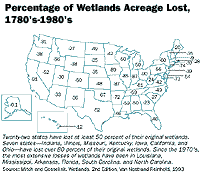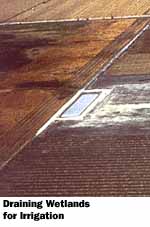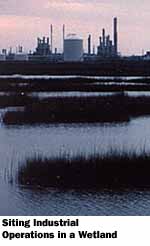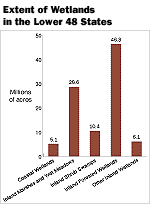|

 Current Situation Current Situation
The lower 48 states contained an estimated 105.5 million acres of wetlands in 1997. This is an area about the size of California. In the 1980s, an estimated 170-200 million acres of wetland existed in Alaska-- covering slightly more than half of the state-- while Hawaii had 52,000 acres. Next to Alaska, Florida (11 million), Louisiana (8.8 million), Minnesota (8.7 million), and Texas (7.6 million) have the largest wetland acreage.
 In the 1600s, over 220 million acres of wetlands are thought to have existed in the lower 48 states. Since then, extensive losses have occurred, and over half of our original wetlands have been drained and converted to other uses. The years from the mid-1950s to the mid- 1970s were a time of major wetland loss, but since then the rate of loss has decreased. In the 1600s, over 220 million acres of wetlands are thought to have existed in the lower 48 states. Since then, extensive losses have occurred, and over half of our original wetlands have been drained and converted to other uses. The years from the mid-1950s to the mid- 1970s were a time of major wetland loss, but since then the rate of loss has decreased.
 Between 1986 and 1997, an estimated 58,500 acres of wetlands were lost each year in the conterminous United States. Various factors have contributed to the decline in the loss rate including implementation and enforcement of wetland protection measures and elimination of some incentives for wetland drainage. Public education and outreach about the value and functions of wetlands, private land initiatives, coastal monitoring and protection programs, and wetland restoration and creation actions have also helped reduce overall wetland losses. Between 1986 and 1997, an estimated 58,500 acres of wetlands were lost each year in the conterminous United States. Various factors have contributed to the decline in the loss rate including implementation and enforcement of wetland protection measures and elimination of some incentives for wetland drainage. Public education and outreach about the value and functions of wetlands, private land initiatives, coastal monitoring and protection programs, and wetland restoration and creation actions have also helped reduce overall wetland losses.
In
addition to these losses, many other wetlands have suffered degradation
of functions, although calculating the magnitude of the degradation is
difficult.
These losses, as well as degradation, have greatly diminished our
nation's wetlands resources; as a result, we no longer have the benefits
they provided. The increase in flood damages, drought damages, and the
declining bird populations are, in part, the result of wetlands
degradation and destruction.


Wetlands have been degraded in ways that are not as obvious as direct
physical destruction or degradation. Other threats have included chemical
contamination, excess nutrients, and sediment from air and water. Global
climate change could affect wetlands through increased air temperature;
shifts in precipitation; increased frequency of storms, droughts, and
floods; increased atmospheric carbon dioxide concentration; and sea level
rise. All of these impacts could affect species composition and wetland
functions.
Major Causes of Wetland Loss and Degradation
 Human Actions
Human Actions
- Drainage
- Dredging and stream channelization
- Deposition of fill material
- Diking and damming
- Tilling for crop production
- Levees
- Logging
- Mining
- Construction
- Runoff
- Air and water pollutants
- Changing nutrient levels
- Releasing toxic chemicals
- Introducing nonnative species
- Grazing by domestic animals
Natural Threats
- Erosion
- Subsidence
- Sea level rise
- Droughts
- Hurricanes and other storms
|
|

